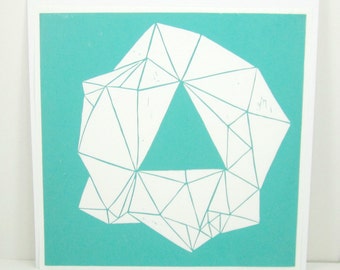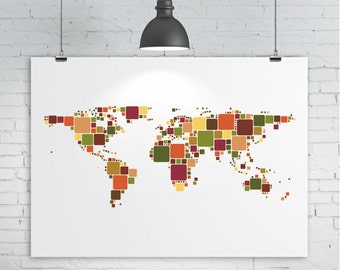Quite like these geometric worlds, think they work really well together.
Tuesday, 2 December 2014
What Makes Geometric Abstraction So Exciting?
http://www.artspace.com/magazine/art_101/art_101_geometric_abstraction
When abstract art burst onto the stage in the Western art world in the early 20th century, its practitioners quickly resolved themselves into two distinct camps: the gestural abstractionists, who built upon the liberatingly loose compositions of Post-Impressionists like Cezanne to create non-objective paintings emphasizing the artist's hand, and the geometric abstractionists, who seized on the it-is-what-it-is essentialism of Euclidean geometric shapes.
Following the developments of Cubist and Futurist painting—in which the natural world was translated into a stark pictorial language of shapes, lines, and angles—Russia was one of the primary breeding grounds of pure abstraction, with Wassily Kandinsky doing much to popularize geometric art before gravitating to the gestural camp in later years. But it was Kazimir Malevich who today is often viewed as the forefather of geometric abstraction, beginning with his seminal 1915 paintings of black shapes—a circle, a square—on a white ground, and his legendary white-square-on-white-canvas 1919 monochrome.
Though geometry can seem dry and mute in comparison to the flights of fancy in gestural abstraction, the artists who pursued meaning in its rigorous shapes found it anything but. Malevich—who called his visually simple but theoretically dense approach "Suprematism"—declared that his intention was to use geometry to convey "the primacy of pure feeling in creative art," and through it he created totemic works of strange, atavistic power.
His confederate, El Lissitzky, on the other hand, painted lively compositions with shapes that often seem to dance on the canvas, using precise balances of shapes and colors to tell spatial stories—for instance, suggesting that a static shape is actually in the process of falling, or rising—or even convey political propaganda. (The most famous example of this is the 1919 pro-Bolshevik poster Beat the Whites With the Red Wedge.) Mondrian, of course, elevated these spatial dynamics to the point where his last painting, Broadway Boogie Woogie, nearly reverted to representationalism by so vividly evoking the traffic flow of New York City's streets.
From these beginnings, geometric abstraction endured throughout the 20th century as a visual and theoretical counterpoint to gestural movements like Abstract Expressionism, rendered by different artists in many different ways. Josef Albers, for instance, employed compositions of layered squares to explore the manifold qualities of color, considering how different hues relate to each other and their effect on the perception of viewers. Other artists brought geometric shapes into three dimensions as sculpture, with Sol LeWitt's cubic stacks being expressions of conceptual-art ideas, Dan Flavin's fluorescent-light arrangements functioning as paragons of Minimalism, and Richard Tuttle's scrappy arrangements recalling the playfullness of El Lissitzky.
Meanwhile, still other artists looked back on Malevich's monochrome with paintings that conveyed form only through the shape of the canvas, like Robert Rauschenberg's early 1951 white paintings (which he considered stages for the interplay of ambient light and shadow) and Brice Marden's imposing examples from the 1960s. Artists associated with "hard-edge" painting in the 1960s, such as Ellsworth Kelly, Kenneth Noland, and Frank Stella, rejected the subjective, gestural emphasis of Abstract Expressionism in favor of sharply defined areas of color.
Today the lineage of geometric abstraction is being continued by younger artists in all manner of ways, from the crisp paintings of Sarah Morris that combine Mondrian's compositional intricacy with vernacular touches to the colorful arrangements of talents like Mai Braun that pursue an obsession with color that Albers would recognize. To see a variety of approaches to this powerful approach to art, explore our geometric abstraction collection at right.
When abstract art burst onto the stage in the Western art world in the early 20th century, its practitioners quickly resolved themselves into two distinct camps: the gestural abstractionists, who built upon the liberatingly loose compositions of Post-Impressionists like Cezanne to create non-objective paintings emphasizing the artist's hand, and the geometric abstractionists, who seized on the it-is-what-it-is essentialism of Euclidean geometric shapes.
Following the developments of Cubist and Futurist painting—in which the natural world was translated into a stark pictorial language of shapes, lines, and angles—Russia was one of the primary breeding grounds of pure abstraction, with Wassily Kandinsky doing much to popularize geometric art before gravitating to the gestural camp in later years. But it was Kazimir Malevich who today is often viewed as the forefather of geometric abstraction, beginning with his seminal 1915 paintings of black shapes—a circle, a square—on a white ground, and his legendary white-square-on-white-canvas 1919 monochrome.
Though geometry can seem dry and mute in comparison to the flights of fancy in gestural abstraction, the artists who pursued meaning in its rigorous shapes found it anything but. Malevich—who called his visually simple but theoretically dense approach "Suprematism"—declared that his intention was to use geometry to convey "the primacy of pure feeling in creative art," and through it he created totemic works of strange, atavistic power.
His confederate, El Lissitzky, on the other hand, painted lively compositions with shapes that often seem to dance on the canvas, using precise balances of shapes and colors to tell spatial stories—for instance, suggesting that a static shape is actually in the process of falling, or rising—or even convey political propaganda. (The most famous example of this is the 1919 pro-Bolshevik poster Beat the Whites With the Red Wedge.) Mondrian, of course, elevated these spatial dynamics to the point where his last painting, Broadway Boogie Woogie, nearly reverted to representationalism by so vividly evoking the traffic flow of New York City's streets.
From these beginnings, geometric abstraction endured throughout the 20th century as a visual and theoretical counterpoint to gestural movements like Abstract Expressionism, rendered by different artists in many different ways. Josef Albers, for instance, employed compositions of layered squares to explore the manifold qualities of color, considering how different hues relate to each other and their effect on the perception of viewers. Other artists brought geometric shapes into three dimensions as sculpture, with Sol LeWitt's cubic stacks being expressions of conceptual-art ideas, Dan Flavin's fluorescent-light arrangements functioning as paragons of Minimalism, and Richard Tuttle's scrappy arrangements recalling the playfullness of El Lissitzky.
Meanwhile, still other artists looked back on Malevich's monochrome with paintings that conveyed form only through the shape of the canvas, like Robert Rauschenberg's early 1951 white paintings (which he considered stages for the interplay of ambient light and shadow) and Brice Marden's imposing examples from the 1960s. Artists associated with "hard-edge" painting in the 1960s, such as Ellsworth Kelly, Kenneth Noland, and Frank Stella, rejected the subjective, gestural emphasis of Abstract Expressionism in favor of sharply defined areas of color.
Today the lineage of geometric abstraction is being continued by younger artists in all manner of ways, from the crisp paintings of Sarah Morris that combine Mondrian's compositional intricacy with vernacular touches to the colorful arrangements of talents like Mai Braun that pursue an obsession with color that Albers would recognize. To see a variety of approaches to this powerful approach to art, explore our geometric abstraction collection at right.
Ideas - Mixing the two
Could i use the difference of geometric and organic in ways to intertwine both traditional and digital art?
What is the Definition of Shape in Art?
Definition:
(noun) - A shape is one of the seven elements of art. When defining it within the study of art, shape is anenclosed space, the boundaries of which are defined by other elements of art (i.e.: lines, colors, values, textures, etc.).
Shapes are limited to two dimensions: length and width.Geometric shapes -- circles, rectangles, squares, triangles and so on -- have the clear edges one achieves when using tools to create them. Organic shapes have natural, less well-defined edges (think: an amoeba, or a cloud).
T Belt
https://www.pinterest.com/pin/387309636678158405/
I feel the use of geometric shapes gives alot of depth, texture and feeling, gives the look of traditional and digital techniques.
Tyler Beard
http://www.saatchiart.com/art/Collage-Geometric-Portals-Swiss-Alps-series/329411/183843/view
I love the fact that the shape really gives each image depth and shape just by the way the image is rapped around it. Nice technique.
Jason Blackmore
http://www.saatchiart.com/art/Collage-Construct-with-whites-browns-greys/321564/181529/view
I like the use of these shapes, they almost have all the elements to make up an environment from snippets of colour.
I like the use of these shapes, they almost have all the elements to make up an environment from snippets of colour.
Geometric abstraction
Geometric abstraction is a form of abstract art based on the use of geometric forms sometimes, though not always, placed in non-illusionistic space and combined into non-objective (non-representational) compositions. Throughout 20th-century art historical discourse, critics and artists working within the reductive or pure strains of abstraction have often suggested that geometric abstraction represents the height of a non-objective art practice, which necessarily stresses or calls attention to the root plasticity and two-dimensionality of painting as an artistic medium. Thus, it has been suggested that geometric abstraction might function as a solution to problems concerning the need for modernist painting to reject the illusionistic practices of the past while addressing the inherently two dimensional nature of the picture plane as well as the canvas functioning as its support. Wassily Kandinsky, one of the forerunners of pure non-objective painting, was among the first modern artists to explore this geometric approach in his abstract work. Other examples of pioneer abstractionists such as Kasimir Malevich and Piet Mondrian have also embraced this approach towards abstract painting. Mondrian's painting Composition No. 10, 1939-1942, characterized by primary colors, white ground and black grid lines clearly defined his radical but classical approach to the rectangle.
However, geometric abstraction cannot only be seen as an invention of 20th century avant-garde artists or movements. It is present among many cultures throughout history both as decorative motifs and as art pieces themselves. Islamic art, in its prohibition of depicting religious figures, is a prime example of this geometric pattern-based art, which existed centuries before the movement in Europe and in many ways influenced this Western school. Aligned with and often used in the architecture of Islamic civilations spanning the 7th century-20th century, geometric patterns were used to visually connect spirituality with science and art, both of which were key to Islamic thought of the time.
Abstract art has also historically been likened to music in its ability to convey emotional or expressive feelings and ideas without reliance upon or reference to recognizable objective forms already existent in reality. Wassily Kandinsky has discussed this connection between music and painting, as well as how the practice of classical composition had influenced his work, at length in his seminal essay Concerning the Spiritual in Art.
Expressionist abstract painting, as practiced by artists such as Jackson Pollock, Franz Kline, Clyfford Still, and Wols, represents the opposite of geometric abstraction.
Presentation 2
So yesterday we had out second lot of presentations.
The feedback i got was encouraging and that im asking the right questions, i need to carry on with creating stuff but make sure im not going to cliche.
My ideas now stand on making geometrical shapes to look into form and composition for the task.
But also keeping my style coming through.
I feel due to November being a dud of a month i will get everything out the bag over Christmas ready to progress in second semester.
The feedback i got was encouraging and that im asking the right questions, i need to carry on with creating stuff but make sure im not going to cliche.
My ideas now stand on making geometrical shapes to look into form and composition for the task.
But also keeping my style coming through.
I feel due to November being a dud of a month i will get everything out the bag over Christmas ready to progress in second semester.
Subscribe to:
Comments (Atom)







